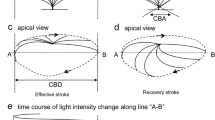Abstract
As the ex vivo lifetime of nasal ciliary cells is limited, these cells have to be transferred to a culture medium for analysis with vital cytology immediately. Although the ciliary beat frequency (CBF) is likely to change over time, sufficient data regarding changes in the ex vivo CBF has not been published to date. In the present study, nasal epithelial cells were harvested from the mucosa of the inferior turbinate of 19 healthy volunteers with a cytology brush. Beating cilia were visualized with phase-contrast microscopy. Over a 12-h timeframe, 2 s epochs of video were captured every 5 min from the identical group of cells using a high-speed digital camera with a sampling rate of 100 fps. Temperature was maintained at about 22°C and controlled by an infrared pyrometer. The CBF rapidly increased by 47 ± 53% during the first 3 h of measurement. A relative plateau followed this increase from 3 to 9 h. After 9 h, CBF reduced linearly. After 12 h, the mean frequency reduced to 20 ± 69% of baseline. However, there was considerable variance between the samples. The initial increase in CBF has not been reported previously. This interval seems to be unsuitable for meaningful measurements. Measurements of CBF are most reliable during the plateau phase between 3 and 9 h. After 9 h, there is clearly a significant decrease in CBF, together with a considerable interindividual variance.



Similar content being viewed by others
References
Chapman KR, Allen LJ, Romet TT (1990) Pulmonary function in normal subjects following exercise at cold ambient temperatures. Eur J Appl Physiol Occup Physiol 60(3):228–232
Satir P, Sleigh MA (1990) The physiology of cilia and mucociliary interactions. Annu Rev Physiol 52:137–155
Hilfinger A, Chattopadhyay AK, Julicher F (2009) Nonlinear dynamics of cilia and flagella. Phys Rev E Stat Nonlin Soft Matter Phys 79(5 Pt 1):051918
Stannard W, O’Callaghan C (2006) Ciliary function and the role of cilia in clearance. J Aerosol Med 19(1):110–115
Jorissen M, Bessems A (1995) Influence of culture duration and ciliogenesis on the relationship between ciliary beat frequency and temperature in nasal epithelial cells. Eur Arch Otorhinolaryngol 252(8):451–454
Shah AS et al (2009) Motile cilia of human airway epithelia are chemosensory. Science 325(5944):1131–1134
Chen B et al (2006) Altered sinonasal ciliary dynamics in chronic rhinosinusitis. Am J Rhinol 20(3):325–329
Elliott MK, Sisson JH, Wyatt TA (2007) Effects of cigarette smoke and alcohol on ciliated tracheal epithelium and inflammatory cell recruitment. Am J Respir Cell Mol Biol 36(4):452–459
Proctor DF et al (1978) Nasal mucociliary clearance in man. Ciba Found Symp 1978(54):219–234
Andersen I, Proctor DF (1983) Measurement of nasal mucociliary clearance. Eur J Respir Dis Suppl 127:37–40
Gilain L et al (1993) Nasal epithelial cell culture as a tool in evaluating ciliary dysfunction. Acta Otolaryngol 113(6):772–776
Gray J (1930) The mechanism of ciliary movement. VI Photographic and stroboscopic analysis of ciliary movement. In: Proceedings of the Royal Society of London Series B, Containing Papers of a Biological Character 107(751):19
Lee WI, Verdugo P (1976) Laser light-scattering spectroscopy: a new application in the study of ciliary activity. Biophys J 16(9):1115–1119
Reimer A, Toremalm NG (1978) The mucociliary activity of the upper respiratory tract. II. A method for in vivo studies on maxillary sinus mucosa of animals and human beings. Acta Otolaryngol 86(3–4):283–288
Kennedy JR, Duckett KE (1981) The study of ciliary frequencies with an optical spectrum analysis system. Exp Cell Res 135(1):147–156
Sisson JH et al (2003) All-digital image capture and whole-field analysis of ciliary beat frequency. J Microsc 211(Pt 2):103–111
Thomas B, Rutman A, O’Callaghan C (2009) Disrupted ciliated epithelium shows slower ciliary beat frequency and increased dyskinesia. Eur Respir J 34(2):401–404
R-Development-Core-Team (2009) R: a language and environment for statistical computing. R Foundation for Statistical Computing, Vienna
Ma W, Silberberg SD, Priel Z (2002) Distinct axonemal processes underlie spontaneous and stimulated airway ciliary activity. J Gen Physiol 120(6):875–885
Zhang L, Sanderson MJ (2003) Oscillations in ciliary beat frequency and intracellular calcium concentration in rabbit tracheal epithelial cells induced by ATP. J Physiol 546(Pt 3):733–749
Salathe M (2007) Regulation of mammalian ciliary beating. Annu Rev Physiol 69:401–422
Konig P et al (2009) Serotonin increases cilia-driven particle transport via an acetylcholine-independent pathway in the mouse trachea. PLoS ONE 4(3):e4938
Lorenzo IM et al (2008) TRPV4 channel participates in receptor-operated calcium entry and ciliary beat frequency regulation in mouse airway epithelial cells. Proc Natl Acad Sci USA 105(34):12611–12616
Mercke U (1975) The influence of varying air humidity on mucociliary activity. Acta Otolaryngol 79(1–2):133–139
Acknowledgments
This study was supported by Fisher and Paykel Healthcare Limited, Auckland, New Zealand.
Conflict of interest statement
There is no conflict of interest.
Author information
Authors and Affiliations
Corresponding author
Rights and permissions
About this article
Cite this article
Sommer, J.U., Gross, S., Hörmann, K. et al. Time-dependent changes in nasal ciliary beat frequency. Eur Arch Otorhinolaryngol 267, 1383–1387 (2010). https://doi.org/10.1007/s00405-010-1211-5
Received:
Accepted:
Published:
Issue Date:
DOI: https://doi.org/10.1007/s00405-010-1211-5




